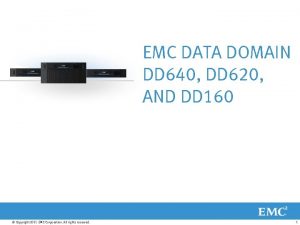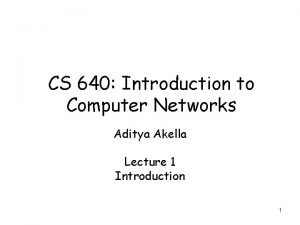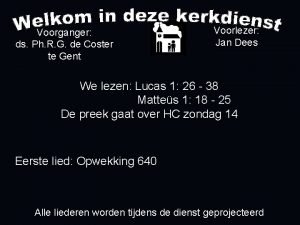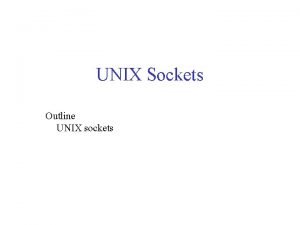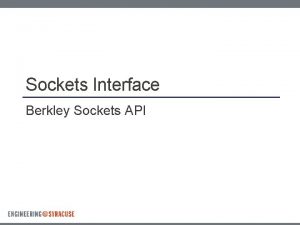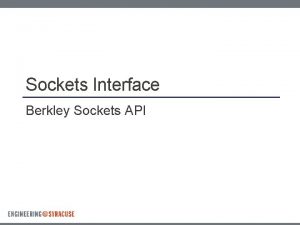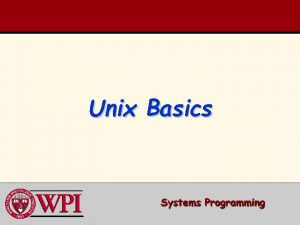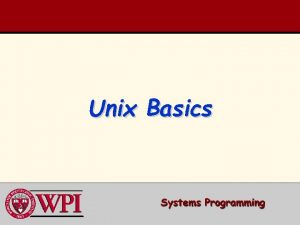UNIX Sockets Outline UNIX sockets CS 640 1












- Slides: 12

UNIX Sockets Outline UNIX sockets CS 640 1

Berkeley Sockets • Networking protocols are implemented as part of the OS – The networking API exported by most OS’s is the socket interface – Originally provided by BSD 4. 1 c ~1982. • The principal abstraction is a socket – Point at which an application attaches to the network – Defines operations for creating connections, attaching to network, sending/receiving data, closing. CS 640 2

Connection-oriented example (TCP) Server Socket() Bind() Client Listen() Socket() Accept() Block until connect Recv() Process request Send() Connection Establishmt. Data (request) Connect() Send() Data (reply) Recv() CS 640 3

Connectionless example (UDP) Server Socket() Client Bind() Socket() Recvfrom() Block until Data from client Bind() Data (request) Sendto() Process request Sendto() Data (reply) Recvfrom() CS 640 4

Socket call • Means by which an application attached to the network • int socket(int family, int type, int protocol) • Family: address family (protocol family) – AF_UNIX, AF_INET, AF_NS, AF_IMPLINK • Type: semantics of communication – SOCK_STREAM, SOCK_DGRAM, SOCK_RAW – Not all combinations of family and type are valid • Protocol: Usually set to 0 but can be set to specific value. – Family and type usually imply the protocol • Return value is a handle for new socket CS 640 5

Bind call • Binds a newly created socket to the specified address • Int bind(int socket, struct sockaddr *address, int addr_len) • Socket: newly created socket handle • Address: data structure of address of local system – IP address and port number (demux keys) – Same operation for both connection-oriented and connectionless servers • Can use well known port or unique port CS 640 6

Listen call • Used by connection-oriented servers to indicate an application is willing to receive connections • Int(int socket, int backlog) • Socket: handle of newly creates socket • Backlog: number of connection requests that can be queued by the system while waiting for server to execute accept call. CS 640 7

Accept call • After executing listen, the accept call carries out a passive open (server prepared to accept connects). • Int accept(int socket, struct sockaddr *address, int addr_len) • It blocks until a remote client carries out a connection request. • When it does return, it returns with a new socket that corresponds with new connection and the address contains the clients address CS 640 8

Connect call • Client executes an active open of a connection • Int connect(int socket, struct sockaddr *address, int addr_len) • Call does not return until the three-way handshake (TCP) is complete • Address field contains remote system’s address • Client OS usually selects random, unused port CS 640 9

Send(to), Recv(from) • After connection has been made, application uses send/recv to data • Int send(int socket, char *message, int msg_len, int flags) – Send specified message using specified socket • Int recv(int scoket, char *buffer, int buf_len, int flags) – Receive message from specified socket into specified buffer CS 640 10

Socket Implimentation • Protocol implementation – Process per protocol • Use a separate process to implement each protocol • Messages are passes between processes – Process per message • Use one process to handle each message/communication • Generally more efficient • Buffer use – Applications use buffers as do protocols • Copies are VERY expensive • Message abstraction enables pointers to be used and minimal copies CS 640 11

Practical issues – using sockets • You have to be very careful when using these calls – Specific data structures and formats – Ports cannot be less than 1024 • You can use other tools to see if things are working – Tcpdump – /proc – netstat • • Client and server can be on same system Think about error handling methods Refer to Stevens Baby steps!! CS 640 12




